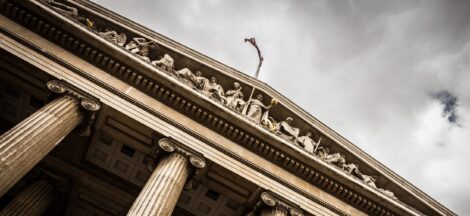The Federal Reserve Board has expanded the loan options available to businesses under the new Main Street Lending Program, and opened the program to larger businesses.
The Main Street Lending Program was announced last month to help credit flow to small and mid-sized businesses that were in sound financial shape before the coronavirus pandemic. A start date for the program is expected to be announced soon.
The Fed announced a series of changes after receiving more than 2,200 letters in response to a request for public feedback.
These changes include:
-
Creating a third loan option;
-
Lowering the minimum loan size for certain loans; and
-
Expanding the pool of businesses eligible to borrow.
Three Loan Types
The Main Street Lending Program was established under Section 13(3) of the Federal Reserve Act. The Treasury Department, using funds from the CARES Act, will make a $75 billion investment in a special purpose vehicle (SPV) to provide up to $600 billion in loans.
There are three loan types (up from two under the initial program): new loans, priority loans, and upsized loans. The SPV will purchase 95% participations in new and upsized Main Street loans, and 85% participations in priority loans. The Fed will stop purchasing participations in the loans on September 30, 2020, unless the program is extended. The guaranteed sale of participations in each loan should encourage lenders to extend loans to businesses, knowing they assume a small portion of the risk.
New Loans: the minimum loan size is $500,000 (down from $1 million under the initial program). The maximum loan size is the lesser of 1) $25 million or 2) an amount that, when added to the borrower’s existing outstanding and committed but undrawn debt, does not exceed four times the borrower’s 2019 earnings before interest, taxes, depreciation, and amortization.
Priority Loan: the minimum loan size is $500,000. The maximum is the lesser of 1) $25 million or 2) an amount that, when added to the borrower’s existing outstanding and committed but undrawn debt, does not exceed six times the borrower’s 2019 earnings before interest, taxes, depreciation, and amortization.
Upsized Loan: the minimum loan size is $10 million. The maximum is the lesser of 1) $200 million, 2) 35% of the borrower’s existing outstanding and committed but undrawn bank debt, or 3) an amount that, when added to the borrower’s existing outstanding and committed but undrawn debt, does not exceed six times the borrower’s 2019 earnings before interest, taxes, depreciation, and amortization.
Shared features of the each of the loan types include:
-
four year maturity;
-
principal and interest payments are deferred for one year (unpaid interest will be capitalized);
-
loans will accrue interest at an adjustable rate equal to LIBOR (one or three months) plus 300 basis points;
-
prepayment without penalty is allowed
A new or priority loan cannot be, either at the time of origination or any time during the term of the loan, contractually subordinated in terms of priority to any of the borrower’s other loans or debt instruments.
For an upsized loan, the upsized tranche of the loan, at the time of upsizing and and at all times the upsized tranche is outstanding, must be senior to or pari passu with, in terms of priority and security, the borrower’s other loans or debt instruments, other than mortgage debt.
Business Size Requirements
The eligibility requirements for borrowers are generally the same for each of the three loan types. The business must have been established before March 13, 2020 and have either 1) 15,000 employees or fewer or 2) had annual revenues in 2019 of $5 billion or less.
For the purposes of the loan program, a “business” is an entity that is organized for profit as a partnership; a LLC, corporation, or association; a trust or cooperative; a joint venture with no more than 49% participation by foreign entities; or a certain tribal business concern.
When counting employees, businesses must include full-time, part-time, seasonal, or otherwise employed persons, not including volunteers and independent contractors. The Small Business Administration’s affiliation rules apply when determining the employee and revenue count, under the revised program.
Venture capital and private equity-backed companies could be considered affiliates with their portfolio companies, depending on the circumstances. For example, under the SBA rules, a venture/PE fund would be affiliated with a portfolio company if the fund has ownership, or the power to control, 50% or more of the company’s voting stock. Control can also arise through management or other relationships between the fund and the company. A minority shareholder, through charter provisions, bylaws or a shareholders agreement, that has the ability to “prevent a quorum or otherwise block action by the board of directors or shareholders” would be deemed to control the company. Companies that have substantially identical business or economic interests may also be treated as one. Affiliation can also be found when one or more officers, directors, managing members, or general partners of a fund control the Board of Directors or the management of the business.
Other Eligibility Requirements
Businesses seeking Main Street loans must commit to make reasonable efforts to maintain payroll and retain workers during the term of the loan. Borrowers must also follow compensation, stock repurchase, and dividend restrictions that apply to direct loan programs under the CARES Act, such as:
-
no employee whose total compensation exceeded $425,000 in calendar year 2019 can receive compensation higher than that individual received in 2019, beginning the year of the loan and for up to 1 year after the loan is no longer outstanding. For employees that made over $3 million, compensation cannot be more than 50% of the excess over $3 million of the total compensation received in 2019;
-
and the business cannot pay dividends or make other capital distributions with respect to the common stock of the eligible business until 1 year after the loan is no longer outstanding.
Other requirements include:
-
The business must have been created or organized in the U.S., or under the laws of the United States, with significant operations in and a majority of its employees based in the U.S.;
-
The businesses must refrain from repaying the principal balance of, or paying any interest on, any debt until the loan is repaid in full, unless the debt or interest payment is mandatory and due;
-
The borrower cannot seek to cancel or reduce any of its committed lines of credit with the bank, or any other lender.;
-
The borrower must certify that it believes that, as of the date of the origination of the loan, it has the ability to meet its financial obligations for at least the next 90 days and doesn’t expect to file for bankruptcy during that time;
-
The borrower must attest that it requires financing due to the exigent circumstances presented by the COVID-19 pandemic.
-
The borrower should also make “reasonable efforts” to maintain its payroll and retain its employees while the loan is outstanding.
The businesses cannot be an “ineligible business.” This includes, among other things, those that are primarily engaged in lending, certain passive businesses owned by developers and landlords and life insurance companies.
The business must have been in sound financial condition before the coronavirus pandemic. If the borrower had other loans outstanding with the lender as of December 31, 2019, the loans must have had an internal risk rating equivalent to a “pass” in the Federal Financial Institutions Examination Council’s supervisory rating system.
The Main Street loan program is different from the Paycheck Protection Program, a loan program for small businesses that was part of the CARES Act. Businesses that have received PPP loans are allowed to borrow under the Main Street program, provided they are eligible.
Non-profit organizations are not eligible for Main Street loans, although the Fed said it is “evaluating a separate approach to meet their unique needs.”
Eligible Lenders
Lenders will assess each potential borrower’s financial condition at the time of the loan application, and are expected to collect the required certifications from each borrower.
Eligible lenders are include:
-
A U.S. federally insured depository institution, including banks, savings associations and credit unions;
-
A U.S. branch or agency of a foreign bank;
-
A U.S. bank holding company;
-
A U.S. savings or loan holding company;
-
A U.S. intermediate holding company of a foreign banking organization; and
-
A U.S. subsidiary of any of the foregoing.
The lender will pay the SPV a transaction fee calculated off the principal amounts of the loan at the time of origination. This fee may be passed onto the borrower. The borrower will also pay the lender an origination fee.





